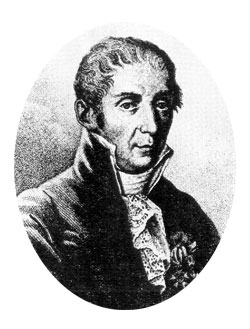
|
| Alessandro Giuseppe Antonio Anastasio Volta
(1745-1827) was the great antagonist of Galvani, and his efforts
to refute the theory of animal electricity later resulted in his
invention of the voltaic pile, the first electric battery. The term
volt, a unit of electrical measurement, is named in is honor. Volta was born in Como, Italy (near Milan). In 1774, he began his first academic position as principal of the state Gymnasium in Como. In 1777, he was appointed Professor of Physics at the University of Pavia. Here he began to repeat Galvani’s famous experiments with decapitated frogs. He observed that Galvani had connected brass hooks between the frog’s spinal cord and an iron railing. According to Volta’s interpretation, the muscle twitches were induced by current flowing between two dissimilar metals connected by the moist flesh of the frog’s leg. This led him to develop the first device which demonstrated chemical production of electric current. In 1799, Volta arranged a vertical pile of metal discs (zinc with copper or silver) and separated them from each other with paperboard discs that had been soaked in saline solution. This stack became known as the voltaic pile and was the progenitor for modern alkaline batteries. In his pursuit of the current generated by his primitive batteries, Volta developed several new devices. He invented the electrophore, a forerunner of the capacitor; the condensatore, a device that detected weak electrical current; and the straw electrometer, a meteorology tool which measured atmospheric electricity. In 1801, Volta was summoned to Paris to demonstrate
his discovery before the Academy of Sciences. Napoleon declared
his presentation a triumph, awarded him a gold medal and initiated
the annual Volta Prize in his honor. History does not reveal whether
he also received the traditional kiss on both cheeks. |













